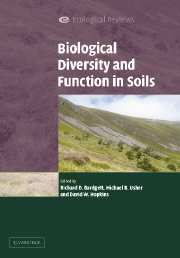Book contents
- Frontmatter
- Contents
- List of contributors
- Preface
- Acknowledgements
- PART I Introduction
- PART II The soil environment
- PART III Patterns and drivers of soil biodiversity
- PART IV Consequences of soil biodiversity
- PART V Applications of soil biodiversity
- 16 Soil biodiversity in rapidly changing tropical landscapes: scaling down and scaling up
- 17 Restoration ecology and the role of soil biodiversity
- 18 Soil biodiversity: stress and change in grasslands under restoration succession
- 19 Soil biodiversity, nature conservation and sustainability
- PART VI Conclusion
- Index
- References
16 - Soil biodiversity in rapidly changing tropical landscapes: scaling down and scaling up
Published online by Cambridge University Press: 17 September 2009
- Frontmatter
- Contents
- List of contributors
- Preface
- Acknowledgements
- PART I Introduction
- PART II The soil environment
- PART III Patterns and drivers of soil biodiversity
- PART IV Consequences of soil biodiversity
- PART V Applications of soil biodiversity
- 16 Soil biodiversity in rapidly changing tropical landscapes: scaling down and scaling up
- 17 Restoration ecology and the role of soil biodiversity
- 18 Soil biodiversity: stress and change in grasslands under restoration succession
- 19 Soil biodiversity, nature conservation and sustainability
- PART VI Conclusion
- Index
- References
Summary
SUMMARY
Habitat modification and fragmentation of remaining pristine areas in the tropics is occurring at a speed that threatens to compromise any serious attempt to assess their value in the biosphere, and catalogue their true biological diversity.
Knowledge about the functional significance of soil biodiversity has been strongly influenced by emphasis on temperate climates and by focusing on particular processes of significance to high-input, intensive agriculture. We do not know how robust our methodologies and our concepts are when applied to low-input systems.
Links between diversity and function are clearer for functions that are relatively specific, such as the roles of ecosystem engineers, or specific nutrient transformations compared with generalist functions, such as decomposition, micrograzing, predation and antibiosis.
Substantial redundancy exists in relation to general functions that could be important for functional stability.
When considering the legume–rhizobium symbiosis as a specific case, rhizobial diversity based on molecular phylogeny is only weakly correlated with specific functions such as ability to form nodules (infectiveness), to fix N2 (effectiveness) and to survive in the soil (adaptation).
Major challenges for the future include developing tools for managing soil biodiversity through manipulation of above-ground vegetation and soil amendments, and understanding the effects of scale to design land use systems for optimal future conservation of the biodiversity of tropical soils.
Introduction
If the soil is said to be the ‘poor man's rainforest’ in terms of the bewildering biodiversity it harbours (Usher 1985), then what status should the soil in the tropical rainforest be assigned?
- Type
- Chapter
- Information
- Biological Diversity and Function in Soils , pp. 295 - 318Publisher: Cambridge University PressPrint publication year: 2005
References
- 8
- Cited by



